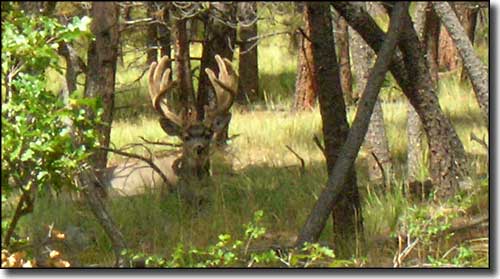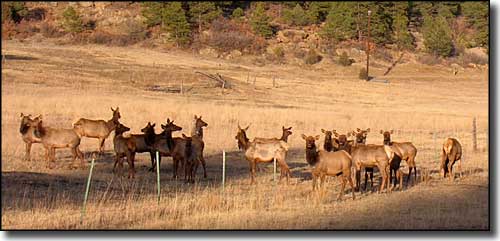 |
Living with Wildlife |
|
|
 Mule deer buck (still in velvet) hiding in the grass |
|
I look at free roaming wildlife as part of the "wealth" of my property. After 14 years, I still love to walk down my driveway at sunrise or sunset and watch the elk and deer grazing in my meadows. I came across a black bear sow and her two cubs one day playing near my catch pond: they were so beautiful it took my breath away. I've watched wild turkeys scrambling up onto my deck to get a drink out of the rain barrel near my hot tub. Walking my dogs up the hill one day, one of my older Lhasa Apsos decided to go the other way. I never did find him again so I'm assuming he challenged a coyote and lost. As he was an inveterate hunter, I like to think he died the same way he lived. This is part of the reality of living in the woods. If I had to go back to the city, I think they'd have to take me kicking and screaming. On the other hand, some of my neighbors... Most wildlife species are motivated by the three natural instincts of survival, growth and reproduction. To do any of these, the animals must eat. Understanding this one simple fact should give you the understanding you need to safely live here and share this habitat with them. Most human-wildlife conflicts are unintentional and, once understood, are easily remedied. Before you plant those rose bushes or ornamental trees out front, do some research and planning. If the wildlife finds those new plants tasty, you have a problem. For landscaping purposes, the best plants to use are indigenous to the immediate area and, hopefully, are readily available to wildlife everywhere other than in your front yard. Your local county extension agent can be real helpful for this. All over the West, the intentional feeding of wildlife is prohibited and highly discouraged. Elsewhere here I've mentioned my city folk neighbors who caused a bear problem unintentionally. At one point, they called the local wildlife officer and asked for a bear trap. He came out to see what the problem was and, after explaining that he was here to protect the bear from people like them, he wrote them a ticket. Then he told them to clean up their act and how to do it or the next fine would be at least double. One simple fact: 99% of all bear problems are caused by people (especially people who think they know better). And the only solution our society has for bear problems ends with a dead bear. I don't want that on my conscience. The discipline required to avoid the problem is really simple: don't leave food around. That includes garbage. Wildlife officers and other law enforcement officers are empowered to shoot dogs chasing wildlife, and the fines involved can be substantial. Dogs and cats are a threat to wildlife all year round so you need to keep them under control at all times. Leaving pet food outdoors complicates the problem, especially in regards to bears, coyotes, skunks, squirrels, porcupines... What follows here is info about some of the wildlife and how to live in harmony with them. Once you are in these woods, you're in their country. Be an educated and respectful guest and everyone will get along fine. As always on this website, this is a work in progress. Over time more will be added here. In the meantime, I hear some elk moving down the hill towards my catch pond. It's calving season and there may be some new babies... where's my binoculars, dear... |
 Elk at my lower fence |
|
|
 |
| Index - Arizona - Colorado - Idaho - Montana - Nevada - New Mexico - Utah - Wyoming National Forests - National Parks - Scenic Byways - Ski & Snowboard Areas - BLM Sites Wilderness Areas - National Wildlife Refuges - National Trails - Rural Life Advertise With Us - About This Site - Privacy Policy |
| Photos courtesy of Sangres.com, CCA ShareAlike 3.0 License. Text Copyright © by Sangres.com. All rights reserved. |